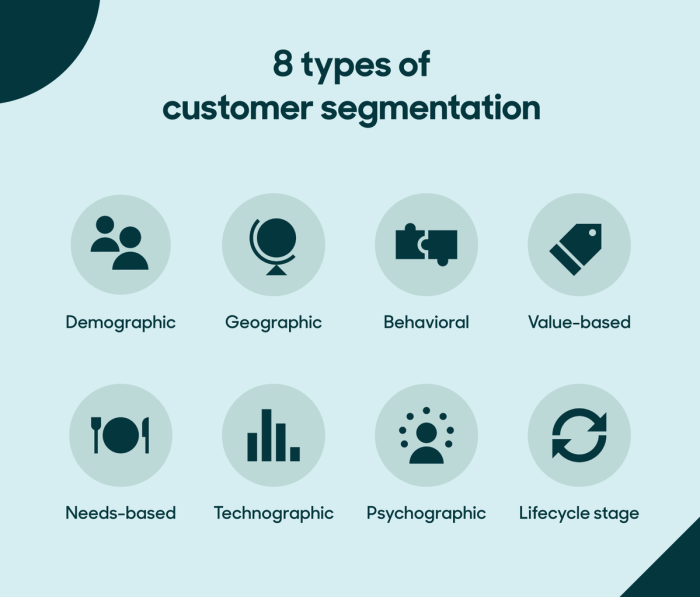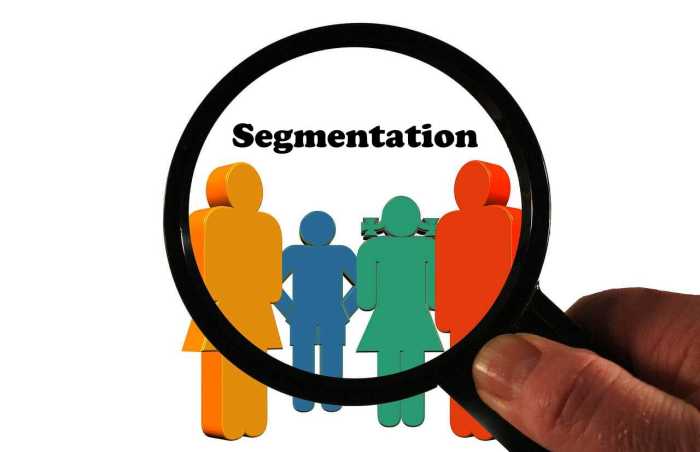Understanding Customer Segmentation sets the stage for targeted marketing success, enhancing customer satisfaction and loyalty in innovative ways. Dive into the world of segmentation to unlock its potential.
Importance of Customer Segmentation
Customer segmentation is like the secret sauce that businesses need to spice up their marketing game. By understanding the different segments of their customer base, businesses can tailor their marketing strategies to target specific groups more effectively. This not only helps in reaching the right audience but also in creating personalized experiences that resonate with customers on a deeper level.
Targeted Marketing Strategies
Customer segmentation allows businesses to divide their customer base into smaller groups based on demographics, behavior, or preferences. This segmentation helps in creating targeted marketing strategies that are more relevant and engaging for each segment. For example, a clothing retailer can send personalized promotions to customers who have previously purchased a specific brand or style, increasing the chances of conversion and customer loyalty.
Impact on Customer Satisfaction and Retention, Understanding Customer Segmentation
When businesses understand their customers on a deeper level through segmentation, they can provide better products, services, and experiences that cater to their specific needs and preferences. This personalized approach leads to higher customer satisfaction levels as customers feel understood and valued. Additionally, targeted marketing based on segmentation can help in retaining customers by building stronger relationships and loyalty, ultimately leading to long-term success for the business.
Types of Customer Segmentation
Customer segmentation is crucial for businesses to understand their target audience better. There are several types of customer segmentation that help in categorizing customers based on different criteria. Let’s explore some of the common types and how they aid in understanding customer behavior.
Demographic Segmentation
Demographic segmentation involves categorizing customers based on demographic factors such as age, gender, income, education, occupation, etc. This type of segmentation helps businesses tailor their marketing strategies according to the specific needs and preferences of different demographic groups. For example, a clothing retailer may target different age groups with specific clothing styles and promotions.
Geographic Segmentation
Geographic segmentation divides customers based on their geographical location such as country, region, city, or climate. This type of segmentation allows businesses to customize their products or services according to the preferences and needs of customers in different locations. For instance, a fast-food chain may offer different menu items in different countries based on local preferences.
Psychographic Segmentation
Psychographic segmentation categorizes customers based on their lifestyle, values, beliefs, interests, and personality traits. This type of segmentation helps businesses create targeted marketing campaigns that resonate with the emotions and motivations of different customer segments. An example is a luxury car brand targeting customers who value status and exclusivity.
Behavioral Segmentation
Behavioral segmentation divides customers based on their purchasing behavior, such as buying frequency, brand loyalty, usage rate, etc. This type of segmentation helps businesses identify patterns in customer behavior and tailor their marketing strategies accordingly. For instance, a grocery store may offer special discounts to frequent shoppers to increase customer loyalty.
Methods for Customer Segmentation: Understanding Customer Segmentation

Customer segmentation is crucial for businesses to tailor their marketing strategies and offerings to specific customer groups. Here are some common methods used for customer segmentation, along with best practices for implementation.
Clustering Analysis
Clustering analysis involves grouping customers based on similarities in their characteristics or behavior. This method helps businesses identify distinct customer segments and target them with personalized marketing campaigns.
RFM Analysis
RFM analysis categorizes customers based on three factors: Recency, Frequency, and Monetary value. By analyzing when customers last made a purchase, how often they buy, and how much they spend, businesses can segment customers effectively.
Machine Learning Algorithms
Machine learning algorithms use predictive analytics to segment customers based on historical data. These algorithms can identify patterns and trends that may not be apparent through manual analysis, enabling businesses to target specific customer segments more accurately.
Data Collection for Customer Segmentation
Businesses collect data for effective customer segmentation through various channels, including customer surveys, transaction history, website analytics, social media interactions, and demographic information. By leveraging data from multiple sources, businesses can gain a comprehensive understanding of their customers and create targeted segmentation strategies.
Implementing Customer Segmentation
To implement customer segmentation successfully, businesses should follow best practices such as defining clear segmentation criteria, regularly updating customer data, testing segmentation strategies, and measuring the effectiveness of targeted marketing campaigns. By continuously refining their segmentation approach, businesses can improve customer engagement and drive revenue growth.
Benefits of Understanding Customer Segmentation

Personalized Marketing:
Customer segmentation allows businesses to tailor their marketing efforts to specific customer groups. By understanding the unique needs and preferences of each segment, companies can create targeted campaigns that resonate with customers on a personal level. This personalized approach can lead to higher conversion rates and increased customer loyalty.
Improved Customer Engagement:
When businesses understand their customer segments, they can engage with them more effectively. By delivering relevant content, promotions, and offers to each segment, companies can capture the attention of their customers and foster stronger relationships. This increased engagement can result in higher customer satisfaction and repeat business.
Driving Product Development and Innovation:
By analyzing customer segments, businesses can gain valuable insights into the needs and preferences of their target audience. This information can be used to guide product development efforts, ensuring that new offerings meet the specific requirements of different customer groups. Understanding customer segments can also inspire innovation, as companies strive to create unique solutions that address the distinct challenges faced by each segment.